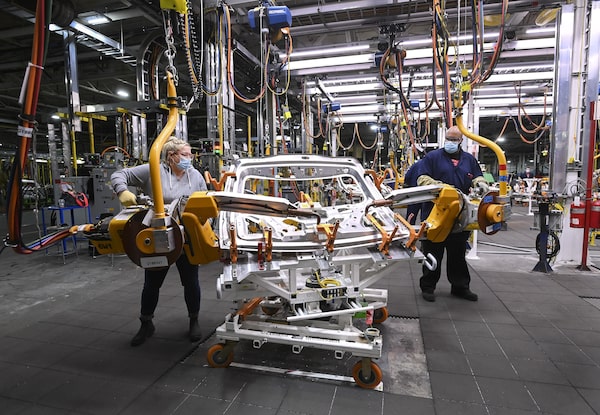
GM workers use human assistance automation to weld vehicle doors at the General Motors assembly plant during the COVID-19 pandemic in Oshawa, Ont., on March 19, 2021.Nathan Denette/The Canadian Press
Washington has handed Canada’s electric vehicle and cleantech industries a big gift, in the form of a historic climate bill that creates new incentives for American consumers to buy battery-powered cars. Now it’s just a matter of not squandering it.
This weekend, the U.S. Senate voted in favour of the Inflation Reduction Act’s US$369-billion in climate and energy spending, which supporters heralded as Washington’s largest-ever climate-change-fighting initiative. Bonus: despite the White House’s previous plans to exclude foreign-made cars from the bill’s tax credit for electric vehicle buyers, the final legislation does not leave major trade partners like Canada on the sidelines.
The bill’s success in the Senate is a major win for President Joe Biden, after months when it appeared his green agenda was being overshadowed by fears about runaway consumer prices and a looming recession. The legislation now goes to the House of Representatives for approval before Mr. Biden signs it into law.
To date, American inability to muster support for doing what’s necessary to slash emissions in its economy, the world’s largest, has held back global progress – and the job has only gotten tougher.
For Canada, a massive opportunity lies in the legislation’s electric vehicle incentives, notably the tax credit, which amounts to US$7,500 for each new car.
Globe editorial: Joe Biden’s surprise climate victory is good for the planet, and Canada
Analysis: Can the most far-reaching climate deal in U.S. history ensure Biden’s legacy after all?
Although Mr. Biden initially looked to be taking a buy-American stance for eligibility, the new bill specifically extends the incentives to electric vehicles built throughout North America, following persuasive lobbying by Canadian federal and provincial governments and industry officials, who stressed that four-fifths of the roughly two million cars and trucks built in Canada each year are exported to the U.S.
The auto industry has been critical of the incentives, saying they would not apply to enough vehicles on the market today because of the number of car components that come from other countries, notably China. But manufacturers could solve that problem – by sourcing North American parts, for instance.
The proposals in the legislation also require that the critical minerals used to build batteries for electric vehicles be produced or processed in countries with which the U.S. has free-trade agreements. Canadian mining companies are already looking to beef up domestic supplies of those minerals.
But Canada still lacks a solid game plan to build up all the elements of its electric vehicle industry. Such a strategy would need to involve the domestic and foreign owners of assembly lines, as well as the suppliers of the parts that get bolted on there.
According to Matthew Fortier, chief executive officer of Accelerate, an alliance formed to draw up the blueprints for Canada zero-emission vehicle supply chain, Canada’s plan must also encompass battery makers, battery recyclers, miners, and companies that develop technology that goes into electrifying Canadian transport.
The strategy must include input from the industry and government, he said, as well as other segments of society across the country that have stakes in making the industry a success. “The focus needs to be, for Canada, on defining our position in the North American and global EV industry,” Mr. Fortier added.
“We’ve got a once-in-a-generation opportunity here. We’ve got the critical minerals that the world needs, we’ve got a mature and integrated auto sector and we’ve got governments that believe this is important.”
Accelerate includes officials from manufacturing, mining, environmental groups, academia and organized labour. It was formed last year in response to worries that Canada was falling behind Europe and other regions when it came to developing the infrastructure needed to support an integrated electric vehicle industry, even as Ottawa was moving ahead with plans to mandate that 100 per cent of new vehicles sold here by 2035 would be of the zero-emission variety.
To date, the federal and provincial governments, notably Ontario and Quebec, have focused on attracting investment in vehicle and battery manufacturing from outside Canada’s borders. Now, Mr. Fortier said, the trick will be to use those investments as hubs for all of the other parts of the economy that feed into electric vehicle manufacturing, including areas such as software development and artificial intelligence.
“The way we’re really going to get caught up and actually lead the pack is to recognize that our opportunity is bigger than just assembly, bigger than auto parts, bigger than batteries,” he said.
“That’s going to take purposeful planning.”
Jeffrey Jones writes about sustainable finance and the ESG sector for The Globe and Mail. E-mail him at jeffjones@globeandmail.com.
 Jeffrey Jones
Jeffrey Jones